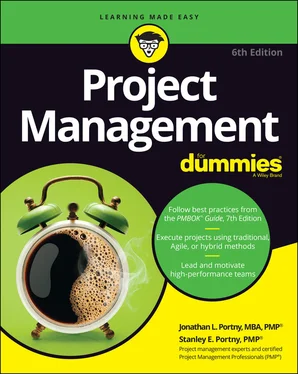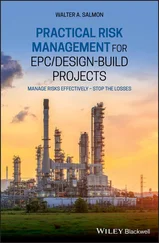 While the bulk of tailoring is performed early in the project, avoid the trap of assuming your initial tailoring will remain relevant throughout the life of the project. The further along a project is, the greater impact changes and delays have and the more difficult it is for the project to absorb them.
While the bulk of tailoring is performed early in the project, avoid the trap of assuming your initial tailoring will remain relevant throughout the life of the project. The further along a project is, the greater impact changes and delays have and the more difficult it is for the project to absorb them.
 Build reminders into your project plan to continually reassess and, where necessary, adjust to ensure your tailoring remains optimally suited for the environment and the work at hand.
Build reminders into your project plan to continually reassess and, where necessary, adjust to ensure your tailoring remains optimally suited for the environment and the work at hand.
Identifying the Models, Methods, and Artifacts to Use
We discussed the value you can realize by tailoring the models, methods, and artifacts that you use to manage your project. Now, let’s review some examples of those models, methods, and artifacts.
 Models are frameworks, mindsets, and approaches for shaping project behavior or solving problems or otherwise satisfying some need. Many models exist solely in and for the project management realm, and other models come from more general methods or philosophies of human behavior, leadership, communication, and motivation. Most of these models could each fill up an entire chapter, or in many cases an entire book, so we won’t go into much detail here. You should take away from this section that there exists a model for nearly every situation, dynamic, personality, and yes, every project, and this is why it is important to tailor the model(s) you intend to use for your project and organization.
Models are frameworks, mindsets, and approaches for shaping project behavior or solving problems or otherwise satisfying some need. Many models exist solely in and for the project management realm, and other models come from more general methods or philosophies of human behavior, leadership, communication, and motivation. Most of these models could each fill up an entire chapter, or in many cases an entire book, so we won’t go into much detail here. You should take away from this section that there exists a model for nearly every situation, dynamic, personality, and yes, every project, and this is why it is important to tailor the model(s) you intend to use for your project and organization.
In lieu of a deep dive into each model, we cover some of the most used model types in project management:
Situational leadership models are one type of leadership model that describes how you can tailor your leadership style to best suit your project team and team members. Situational leadership models, and leadership models in general, are inherently fluid and dynamic, as they offer a framework for responding to different and often changing situations and personalities.
Effective communication is paramount to leading a successful project and communication models consider the different frames of reference of all parties to facilitate this effective communication. The sender of a message most likely brings with them a different perspective than the intended recipient of that message. The background, experiences, and culture of a recipient could notably impact how they receive, interpret, and react to a message. A critical element of communications, nowadays more than ever, is the channel through which that communication occurs. Whether you communicate face-to-face, by telephone, email, instant message, text message, blog, wiki, social media post, or old-fashioned smoke signals, your message could be received and interpreted differently than you intend.The most important consideration when choosing your mode of communication is whether it is situationally appropriate and likely to be interpreted by your recipient as intended. Beyond that, use whatever means of communication is easiest and most convenient for you and your team. In the end, if you’re able to reliably relay the meaning and tone of your message to the correct recipient who is similarly able to accurately receive and interpret it, you’ve chosen an effective communication model for your project.
Your ability to motivate your team is arguably as important as how effectively you communicate with them. Motivation models address what drives people and how you can use that knowledge to your advantage. When you motivate, you create desirable outcomes that contribute to a mutually beneficial arrangement (your resource is motivated to achieve those desirable outcomes and, in doing so, provides a similarly desirable outcome for you and your project).People are often motivated by different factors. Where some are motivated at work by their ability to achieve, grow, and expand their knowledge base, others are motivated by salary, a corner office with a view, or an impressive job title. Where some are motivated by their ability to master a particular skill or to make a meaningful contribution to a larger team effort, others are motivated by their ability to define their own work hours, work from home when they prefer, or choose the projects to which they contribute. It doesn’t matter if you agree with what motivates another person – respect that what motivates them is unique and specific to them and find a way to deliver it so they will ultimately return the favor.
Change models describe necessary activities to achieve successful change management. As with the model types discussed so far, there are many different change models, so let’s focus on some of the common and widely applicable characteristics. It is important to start with a sense of urgency to drive the need for change. Sir Isaac Newton’s First Law of Motion tells us that a body at rest tends to stay at rest, and a body in motion tends to stay in motion, unless acted upon by some outside force. This applies to human behavior as well. People typically gravitate toward a path that upholds the status quo unless you can provide them a compelling reason to change.Depending on your team dynamic, it can be helpful or even essential to form a coalition of influencers who have already accepted the need to change and can help bring other team members along for the ride. Change can often be a lengthy and arduous process, but this can largely be mitigated by creating near-term wins, often referred to as “low hanging fruit” or “quick hits.” While the metaphor of running a marathon is a bit overdone and even cliché at this point, it remains pertinent. For example, running the Boston marathon can be a daunting thought for even the most experienced and well-trained athletes. Breaking the course down into more “bite size” one-mile increments can be more manageable for some (and easy to track since there are mile markers and water stations at each mile). As you lead your team through difficult project tasks, keep in mind that, while it is important to keep your eye on the bigger picture, your team won’t last long enough to achieve the bigger picture if they lose their steam along the way.
Project team development models help you assess your team’s maturity to empower you to further their growth and development throughout the project life cycle. Models of this type follow a similar framework: First, the team comes together; next, the team figures out who’s who and what’s what; next, the team finds their groove; finally, the team completes their mission and moves onto other projects. This is an intentionally oversimplified description because, as with many of the other types, these models are differentiated by their details and nuances. Some models focus more on interpersonal dynamics and development into a cohesive unit; others focus more on the team’s output and their ability to produce increasingly high-quality results as they become more accustomed to working together. Familiarize yourself with the project team development models described in PMBOK 7, specifically, and other literature, in general, so you are informed when you choose the aspects of each model that resonate as you build and nurture your teams.
 Methods are means for achieving or producing an outcome or deliverable (see the description of artifacts later in this chapter for examples) and are typically categorized according to the purpose they serve or activity they help address, as follows:
Methods are means for achieving or producing an outcome or deliverable (see the description of artifacts later in this chapter for examples) and are typically categorized according to the purpose they serve or activity they help address, as follows:
Читать дальше

 While the bulk of tailoring is performed early in the project, avoid the trap of assuming your initial tailoring will remain relevant throughout the life of the project. The further along a project is, the greater impact changes and delays have and the more difficult it is for the project to absorb them.
While the bulk of tailoring is performed early in the project, avoid the trap of assuming your initial tailoring will remain relevant throughout the life of the project. The further along a project is, the greater impact changes and delays have and the more difficult it is for the project to absorb them. Build reminders into your project plan to continually reassess and, where necessary, adjust to ensure your tailoring remains optimally suited for the environment and the work at hand.
Build reminders into your project plan to continually reassess and, where necessary, adjust to ensure your tailoring remains optimally suited for the environment and the work at hand. Models are frameworks, mindsets, and approaches for shaping project behavior or solving problems or otherwise satisfying some need. Many models exist solely in and for the project management realm, and other models come from more general methods or philosophies of human behavior, leadership, communication, and motivation. Most of these models could each fill up an entire chapter, or in many cases an entire book, so we won’t go into much detail here. You should take away from this section that there exists a model for nearly every situation, dynamic, personality, and yes, every project, and this is why it is important to tailor the model(s) you intend to use for your project and organization.
Models are frameworks, mindsets, and approaches for shaping project behavior or solving problems or otherwise satisfying some need. Many models exist solely in and for the project management realm, and other models come from more general methods or philosophies of human behavior, leadership, communication, and motivation. Most of these models could each fill up an entire chapter, or in many cases an entire book, so we won’t go into much detail here. You should take away from this section that there exists a model for nearly every situation, dynamic, personality, and yes, every project, and this is why it is important to tailor the model(s) you intend to use for your project and organization.










